| In addition to the
novel research chemicals we now also
offer a number of Active
Pharmaceutical Ingredients (API's), a
selection of which are detailed below.
For the full list or for further
information please contact us at sales@zerenex.com
Riluzoles
Vericonozole
Sirolimus
Ziprasidone
Letrazole
Tacrolimus
Adapalene
Tenofovir
Bicalutamide
Dorzolomide
Emtricitabine New
Allopurinol New
Dutasteride New
Flutamide New
Riluzoles
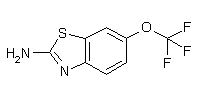
Molecular Weight = 234.20
Molecular Formula = C8H5F3N2OS
CAS Number = 1744-22-5
Riluzole is used to treat amyotrophic
lateral sclerosis. It delays the onset
of ventilator-dependence in selected
patients.
Riluzole has several actions:
- Sodium channel blockade
- High-voltage calcium channel
blockade
- N-methyl-D-aspartate (NMDA)/glutamate
receptor blockade
Riluzole preferentially blocks TTX-S
sodium channels, which are associated
with damaged neurons. This reduces
influx of calcium ions and indirectly
prevents stimulation of glutamate
receptors. Together with direct
glutamate receptor blockade, the
effect of the inhibitory
neurotransmitter glutamate on motor
neurons is greatly reduced.
Vericonozole
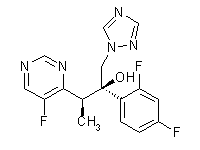
Molecular Weight = 349.32
Molecular Formula = C16H14F3N5O
CAS Number = 137234-62-9
Voriconazole is a triazole that is structurally related to fluconazole.
As with all azole antifungal agents, voriconazole works principally by
inhibition of cytochrome P450 14a-demethylase (P45014DM). This enzyme
is in the sterol biosynthesis pathway that leads from lanosterol to
ergosterol [1602, 1662]. Compared to fluconazole, voriconazole
inhibits P45014DM to a greater extend.
Sirolimus
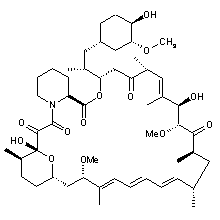
Molecular Weight = 914.20
Molecular Formula = C51H79NO13
CAS Number = 53123-88-9
Sirolimus is a relatively new immunosuppressant drug used to prevent rejection in organ transplantation, and is especially useful in kidney transplants. It is an analogue of
rapamycin. Despite its similar name, it is not a calcineurin-inhibitor like tacrolimus or cyclosporine but has a similar effect on the immune system as it too prevents production of interleukin-2 (IL-2) by immunocompetent T-lymphocytes. It also has an anti-proliferative effect, similar to mycophenolate
mofetil. The mode of action of sirolimus is that it binds to the cytosolic protein FK-binding protein 12 (FKBP12), in a similar way to tacrolimus. However, unlike the tacrolimus-FKBP12 complex which inhibits calcineurin, the sirolimus-FKBP12 complex binds to the mammalian target of rapamycin (mTOR), which inhibits both IL-2 production and lymphocyte proliferation.
The chief advantage sirolimus over calcineurin-inhibitors is that it is not toxic to kidneys. Transplant patients maintained on calcineurin-inhibitors long-term tend to develop impaired kidney function or even chronic renal failure, and this can be prevented by use of sirolimus instead. It is particularly advantageous in patients with kidney transplants for hemolytic-uremic syndrome as this disease is likely to recur in the transplanted kidney if a calcineurin-inhibitor is used.
Sirolimus can also be used alone or in conjuction with calcineurin-inhibitors and/or mycophenolate mofetil, to provide steroid-free immunosuppression regimes.
The anti-proliferative effect of sirolimus has also been used in the production of sirolimus-eluting stents used to treat obstructed coronary arteries, as it is believed that sirolimus-eluting stents are less likely to cause intimal hyperplasia than ordinary stents. This effect may also be found in other arterial stents.
Ziprasidone
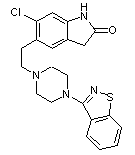
Molecular Weight = 412.94
Molecular Formula = C21H21CIN4OS
CAS Number = 138982-67-9
Ziprasidone is an oral and injectable drug that is used for treating psychoses, for example, schizophrenia. Although the mechanism of action of ziprasidone is not fully known, like other anti-psychotics, it inhibits communication between nerves of the brain. It does this by blocking receptors on the nerves for several neurotransmitters, the chemicals that nerves use to communicate with each other. It is thought that the beneficial effect of ziprasidone is due to its blocking ofdopamine and serotonin receptors. It also inhibits the re-uptake of serotonin and norepinephrine by nerves in the brain like some anti-depressant drugs. Ziprasidone is associated with little or no weight gain, a feature that distinguishes it from other anti-psychotic drugs. Similarly, ziprasidone is unique among anti-psychotic drugs in that it does not increase cholesterol levels.
Letrazole
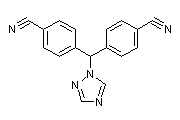
Molecular Weight = 285.31
Molecular Formula = C17H11N5
CAS Number = 112809-51-5
Letrozole is an oral, anti-estrogen drug that is used for treating postmenopausal women with breast cancer. The growth of some breast cancers in postmenopausal women is promoted by estrogens that circulate in the blood, and the adrenal glands are the main source of these circulating estrogens. Letrozole inhibits the enzyme in the adrenal glands (aromatase) that produces the estrogens, estradiol and estrone.
Tacrolimus
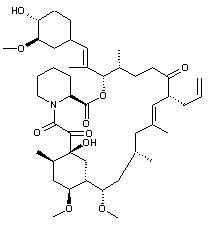
Molecular Weight = 786.07
Molecular Formula = C45H71NO10
CAS Number = 104987-11-3
Tacrolimus is a drug that suppresses the immune system and is used to prevent rejection of transplanted organs. Tacrolimus accomplishes its
immune-suppressing effecting by inhibiting an enzyme (calcineurin) crucial for the multiplication of T-cells, cells that are vital to the immune process. The use of oral tacrolimus allows transplantation specialists to reduce the dose of steroids which are also used to prevent rejection. This "steroid-sparing effect" is important because of the many side effects that can occur when larger doses of steroids are used for a long period of time.
Adapalene
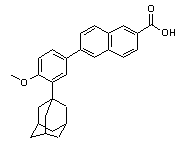
Molecular Weight = 412.53
Molecular Formula = C28H28O3
CAS Number = 106685-40-9
Adapalene is a gel used for the treatment of acne vulgaris (pimples). The exact mechanism of action is not known. Scientists believe that when adapalene is applied to the skin, it affects the growth of skin cells and thereby reduces the formation of pimples.
Tenofovir
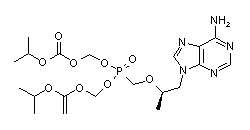
Molecular Weight = 517.48
Molecular Formula = C20H32N5O9P
CAS Number = 202138-50-9
Tenofovir disoproxil fumarate belongs to a class of antiretroviral drugs known as nucleotide analogue reverse transcriptase inhibitors (NtRTIs), which block reverse transcriptase, an enzyme crucial to viral production in HIV-infected people. It is indicated in combination with other antiretroviral agents for the treatment of HIV-1 infection in adults. This indication is based on analyses of plasma HIV-1 RNA levels and CD4 cell counts in controlled studies of tenofovir in treatment-naïve and treatment-experienced adults. There are no study results demonstrating the effect of tenofovir on clinical progression of HIV.
Bicalutamide
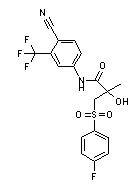
Molecular Weight = 430.38
Molecular Formula = C18H14F4N2O4S
CAS Number =
Bicalutamide is an oral medication that is used for treating cancer of the prostate. It belongs to a class of drugs called anti-androgens which includes flutamide (Eulexin) and nilutamide (Nilandron). Androgens (an example of which is testosterone) are hormones that are produced and released by the adrenal glands. They are responsible for supporting (stimulating) tissues that primarily are thought of as male, for example, the male prostate gland. Male traits that also are influenced by androgens include facial and body hair and small breasts. Anti-androgens prevent the action of androgens by blocking the receptors for androgens on the cells of tissues, for example, the cells of the prostate gland. In addition to normal prostate cells, androgens also have been shown to stimulate the growth of cancer cells within the prostate. Bicalutamide is thought to prevent the growth of prostate cancer by blocking the effects of androgens on the cancer cells.
Dorzolomide
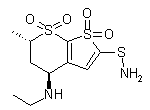
Molecular Weight = 324.44
Molecular Formula = C10H16N2O4S3
CAS Number = 130693-82-2
Many parts of the body, including the eye, contain the enzyme carbonic anhydrase. Carbonic anhydrase plays a key role in controlling the production of fluid particularly within the eye. In turn, the amount of fluid within in the eye determines the pressure within the eye (intraocular pressure). Dorzolamide blocks the enzyme, carbonic anhydrase, and is used as eye drops in the treatment of glaucoma, a condition in which the fluid and pressure in the eye is increased. Following administration of dorzolamide to the eye, intraocular pressure is lowered. This reduces the risk of nerve damage and loss of vision that is caused by increases of intraocular pressure in patients with glaucoma
Emtricitabine

Molecular Weight = 247.24
Molecular Formula = C8H10FN3O3S
CAS Number = 143491-57-0
Emtricitabine is a nucleoside reverse transcriptase inhibitor (NRTI) with activity against Human Immunodeficiency Virus Type 1 (HIV-1).
Emtricitabine works by inhibiting reverse transcriptase, the enzyme that copies HIV RNA into new viral DNA. Emtricitabine is a synthetic nucleoside analogue of cytidine. It is phosphorylated by cellular enzymes to form emtricitabine 5'-triphosphate, which is responsible for the inhibition of HIV-1 reverse transcriptase. It competes with the natural substrate deoxycytidine 5'-triphosphate and incorporates into nascent viral DNA, resulting in early chain termination. Therefore emtricitabine inhibits the activity of HIV-1 reverse transcriptase (RT) both by competing with the natural substrate deoxycytidine 5'-triphosphate and by its incorporation into viral DNA. By inhibiting HIV-1 reverse transcriptase, emtricitabine can help to lower the amount of HIV, or "viral load", in a patient's body and can indirectly increase the number of immune system cells (called T cells or CD4+ T-cells). Both of these changes are associated with healthier immune systems and decreased likelihood of serious illness.
Allopurinol

Molecular Weight = 136.11
Molecular Formula = C5H4N4O
CAS Number = 315-30-0
Allopurinol, a structural analog of the natural purine base hypoxanthine, is used to prevent gout and renal calculi due to either uric acid or calcium oxalate and to treat uric acid nephropathy, hyperuricemia, and some solid tumors.
Allopurinol inhibits the enzyme xanthine oxidase, blocking the conversion of the oxypurines hypoxanthine and xanthine to uric acid. Elevated concentrations of oxypurine and oxypurine inhibition of xanthine oxidase through negative feedback results in a decrease in the concentrations of uric acid in the blood and urine. Allopurinol also facilitates the incorporation of hypoxanthine and xanthine into DNA and RNA, resulting in further reductions of serum uric acid concentrations.
Dutasteride
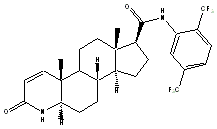
Molecular Weight = 528.53
Molecular Formula = C27H30F6N2O2
CAS Number = 164656-23-9
Dutasteride is a synthetic 4-azasteroid compound that is a selective inhibitor of both the type 1 and type 2 isoforms of steroid 5 alpha-reductase (5AR), an intracellular enzyme that converts testosterone to 5 alpha-dihydrotestosterone (DHT). Dutasteride is indicated for the treatment of symptomatic benign prostatic hyperplasia (BPH) in men with an enlarged prostate gland.
Dutasteride inhibits the conversion of testosterone to 5 alpha-dihydrotestosterone (DHT). DHT is the androgen primarily responsible for the initial development and subsequent enlargement of the prostate gland. Testosterone is converted to DHT by the enzyme 5 alpha-reductase, which exists as 2 isoforms, type 1 and type 2. The type 2 isoenzyme is primarily active in the reproductive tissues while the type 1 isoenzyme is also responsible for testosterone conversion in the skin and liver.
Flutamide

Molecular Weight = 276.21
Molecular Formula = C11H11F3N2O3
CAS Number = 13311-84-7
Flutamide is used for the management of locally confined Stage B2-C and Stage D2 metastatic carcinoma of the prostate
Flutamide is a nonsteroidal antiandrogen that blocks the action of both endogenous and exogenous testosterone by binding to the androgen receptor. In addition Flutamide is a potent inhibitor of testosterone-stimulated prostatic DNA synthesis. Moreover, it is capable of inhibiting prostatic nuclear uptake of androgen
|